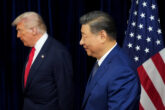May 16, 2023
Controlling Access to Advanced Compute via the Cloud: Options for U.S. Policymakers, Part I
U.S. export controls, as they stand, do not control the provision of cloud computing services and do not stop Chinese companies from accessing controlled chips via Cloud Service Providers (CSPs). In fact, a recent media report alleges that at least one problematic actor in China has found a way around the October 7, 2022 U.S. semiconductor export controls by accessing controlled chips via a CSP. Though this reporting does not provide evidence that the CSP in question was based outside of China, it may become common for Chinese firms to use foreign or overseas cloud services if the performance gap between locally available and foreign AI chips grows significantly due to export restrictions.
We do not recommend controlling access to cloud computing services for entities in China, because, based on our analysis, it does not appear feasible and may have adverse consequences.
If U.S. policymakers are interested in restricting this access, there are two potential pathways forward using export controls. The first is described in this post, and the second—which will focus on controlling access to compute for specific problematic actors and end-uses in China—will be outlined in a following post. In this post, we will outline Goal 1, highlight examples displaying how such controls might work, and discuss the advantages, disadvantages, and limitations of implementing controls in this manner.
Read the full article from CSET.
More from CNAS
-
Transatlantic Security / Technology & National Security
Look Before We Leap on Artificial IntelligenceThis article was originally published on The Dispatch. A debate about the role that artificial intelligence should and will play in society, and how it will affect humanity fo...
By Jon B. Wolfsthal
-
Technology & National Security
Caleb Withers on the Cybersecurity Frontier in the Age of AICaleb Withers, research associate at the Center for a New American Security, joins Kevin Frazier, the AI Innovation and Law Fellow at the University of Texas School of Law and...
By Caleb Withers
-
Technology & National Security
Prepared, Not ParalyzedExecutive Summary The Trump administration has embraced a pro-innovation approach to artificial intelligence (AI) policy. Its AI Action Plan, released July 2025, underscores t...
By Janet Egan, Spencer Michaels & Caleb Withers
-
Indo-Pacific Security / Technology & National Security
Sharper: Tech + ChinaRecent talks between President Donald Trump and Chinese Communist Party General Secretary Xi Jinping placed a spotlight on emerging technologies, from high-end chips to minera...
By Charles Horn & Sevi Silvia




